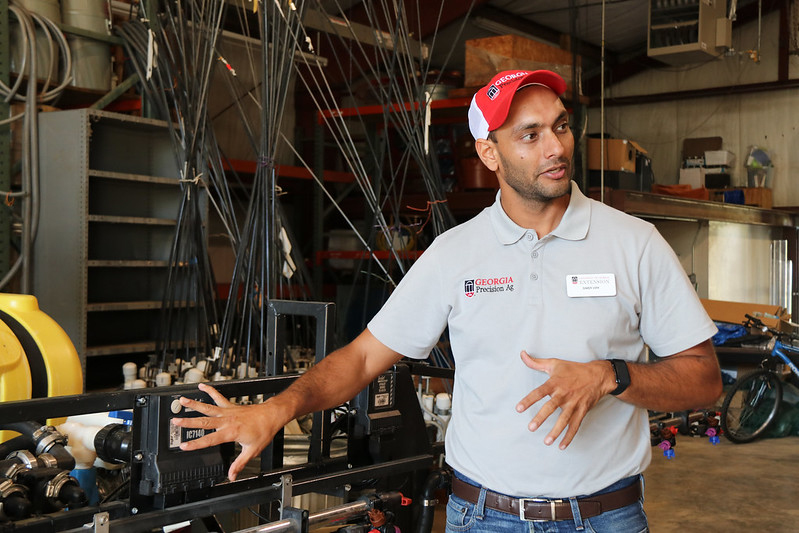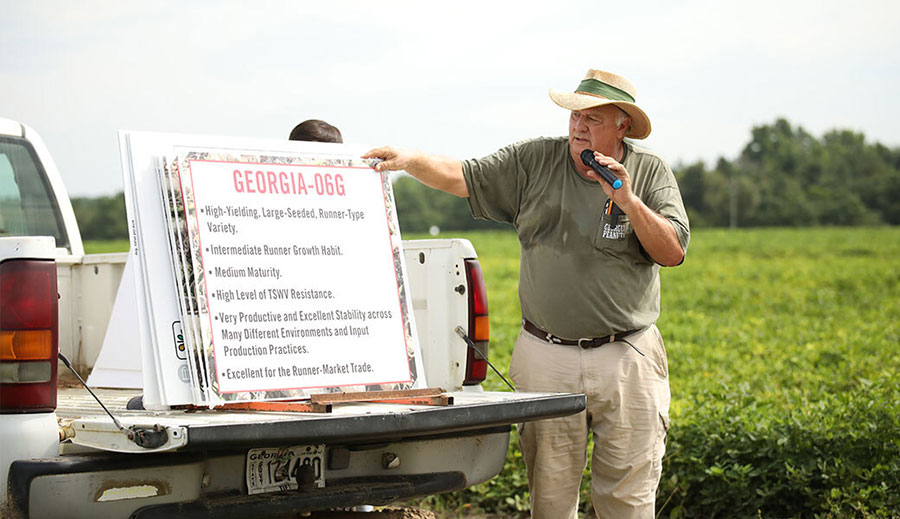
It’s a familiar sight for many — a ground sprayer slowly making rounds in a field, applying pesticides to row crops to give producers the best chance of protecting crops from pests and seeing high yields at harvest. These ground sprayers, with booms that can be up to 120 feet wide, are the tool of choice for producers who are spraying large areas with agricultural chemicals.
But there are times when these large, heavy ground sprayers have limitations. Significant rains or difficult terrain can make it challenging to run the machinery in a particular area or field, preventing a producer from applying pesticides in a timely manner, said Simer Virk, assistant professor in the Department of Crop and Soil Sciences at the University of Georgia’s College of Agricultural and Environmental Sciences. Producers face additional challenges when pests or diseases are present in small areas of their fields — where ground sprayers, with their large booms may not be well-equipped or efficient to provide the targeted application that producers seek.
In coming years, however, there may be a solution for these production woes: sprayer drones.
“In crop production, timing of every operation is critical. We want to address issues in the fields as quickly as possible and that includes the timely application of pesticides and other chemicals that preserve yield potential. Sprayer drones could be another tool in our toolbox that can help us to be timely, especially when the field conditions are not suitable for ground application,” said Virk, who also serves as a precision agriculture specialist with UGA Cooperative Extension.
The use of drones has steadily increased in agricultural production over the last decade, but only recently have researchers begun to consider how this technology might complement the work done by ground sprayers. When properly programmed and operated, sprayer drones are able to fly above crops to apply chemicals using a small tank and spray nozzles, avoiding muddy fields and difficult terrain, all while providing the targeted application that saves money and time.
As with all new technologies in agriculture, there are important questions and concerns to address before researchers and experts are able to provide information and recommendations for producers looking to add spray drones to their operations.
The Federal Aviation Administration (FAA) is the governing body that regulates the use of agricultural drones, or small unmanned aircraft systems (sUAS). Over the last decade, the regulations around operation of sUAS have evolved significantly as the technology has changed and become a more popular option for agricultural researchers, industries and producers across the nation. In years past, agricultural drones have been used primarily to capture imagery that can be used to assess crop damage, scouting and other needs. FAA has issued specifications for weight, height, speed and operation hours for drones of this kind.

“With spray drones, we’ve added a tank and nozzles to the equation, which increases the weight and also changes the purpose of the drone, so the FAA has different set of rules when it comes to aerial application of pesticides. However, they are also constantly reviewing these regulations as drone applications expand in new areas,” Virk said. “We’re hopeful that our work will help regulatory bodies as they seek to accommodate these new needs for agriculture.”
Virk, along with research partners at UGA and experts at Auburn University, is hoping to address some of the most important questions in spray drone technology.
“We have two main objectives in this work: identifying how spray drones can complement the work we’re already doing with ground sprayers and analyzing application performance in order to determine a set of standard and safe practices,” Virk said of UGA’s pioneering work in this area.
Even with ground sprayers, which have been in use for many years, there are continual advancements in nozzle type, flow/droplet size control systems and application technology, among other advancements. With a great deal of variety in spray drone design, size and programming, Virk and his team are running trials that test various available platforms, along with questions about ideal height, coverage estimates, nozzle types, spray drift and flight speed. With this information, they are hopeful that producers will be able to continue safe and sustainable use of pesticides in agriculture, which is important to successful and profitable crop production.
“Right now, there’s a lot we need to learn — with the regulations around spray drones and the precision required for effective pesticide applications, it’s critical that we provide Georgia farmers with the information they need when considering adoption of this new technology.”
Virk said the goal of his research is to equip producers with information that can help them do their job more effectively and precisely, especially when using new technologies like sprayer drones. As both a researcher and an Extension professional, he spends his time conducting trials that move research forward, training students in agricultural technology and working directly with Georgians to make our state’s No. 1 industry stronger and more profitable.
“In many aspects, agriculture is so far ahead of where we were 10 years ago — our hope is that the research we’re doing at UGA will be a critical part of moving our industry forward in the next decades and beyond,” he said.
Follow Virk and Georgia Precision Ag on Twitter for real-time updates on developing precision agriculture technologies. To see the spray drone in action, visit @uga_collegeofag on Instagram.






